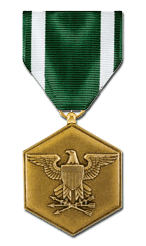
History
Secretary of the Navy Frank Knox established the Navy Commendation Ribbon on November 1, 1943, and announced its creation by ALNAV 11 of January 11, 1944. It was redesignated as the Navy Commendation Ribbon With Metal Pendant on March 22, 1950, and as the Navy Commendation Medal on September 21, 1960. On September 23, 1994, Secretary of the Navy John H. Dalton announced in ALNAV 084/94 that the name had been changed to The Navy and Marine Corps Commendation Medal. The Navy and Marine Corps Commendation Medal has been in effect (with modifications) since December 7, 1941.
The Navy and Marine Corps Commendation Medal was designed and sculpted by Thomas Hudson Jones (1892-1969) of the Army's Institute of Heraldry. The medal was originally designed as the Army Commendation Medal, but its design was subsequently adopted by the Navy. The first person to receive the Navy Commendation Medal (or its predecessor awards) is unknown.
Criteria
The Navy and Marine Corps Commendation Medal may be awarded to service members who, while serving in any capacity with the Navy or Marine Corps, distinguish themselves by heroism, outstanding achievement or meritorious service (but not of sufficient nature to warrant a higher decoration).
- Acts of Heroism
To be awarded for heroism, the act must be worthy of special recognition but not the degree required for the Bronze Star Medal when combat is involved or the Navy and Marine Corps Medal when combat is not involved.
- Meritorious Achievement
To be awarded for meritorious achievement, the act or acts must be outstanding and worthy of special recognition, but not to the degree required for the Bronze Star Medal or Air Medal when combat is involved or the Meritorious Service Medal or Air Medal when combat is not involved. The achievement should be such as to constitute a definite contribution to the naval service, such as an invention or improvement in design, procedure or organization.
- Meritorious Service
To be awarded for meritorious service, the service must be outstanding and worthy of special recognition, but not to the degree required for the Bronze Star Medal or Air Medal when combat is involved or the Meritorious Service Medal or Air Medal when combat is not involved. the award may cover an extended period of time during which a higher award may have been recommended or received for specific act(s). The criteria, however, should not be the period of service involved, but rather the circumstances and conditions under which the service was performed. The performance should be well above that usually expected of an individual commensurate with the individual's grade or rate, and above that degree of excellence which can be appropriately reflected in the individual's fitness report or personnel records.
Wear
The Navy and Marine Corps Commendation Medal is worn after the Joint Service Commendation Medal and before the Joint Service Achievement Medal. Additional awards of the Navy and Marine Corps Commendation Medal are denoted by gold stars five-sixteenths of an inch in diameter. The Combat Distinuishing Device (a bronze letter "V") may be authorized.
Obverse
In the center of a bronze hexagon one and three-eighths inches wide, there is an eagle with horizontally displayed wings bearing on its breast a shield paly of thirteen pieces and a chief. In its talons the eagle holds three arrows.
The shape of the medal was designed to distinguish the Commendation Medal from all other decorations. The eagle is from the Seal of the Department of Defense, and the shield on the eagle's breast is taken from the Great Seal of the United States.
Reverse
In the center of the bronze hexagon there is a plaque for engraving the recipient's name. Above the plaque, in two lines, the inscription in raised letters, FOR MILITARY, and below the plaque, MERIT. Below the word MERIT, and in the bottom point of the medal, there is a spray of laurel, representing achievement.
Ribbon
The ribbon to the Navy and Marine Corps Commendation Medal consists of a field of Myrtle Green with a white stripe one quarter inch wide situated one-eighth of an inch inside each edge of the ribbon.